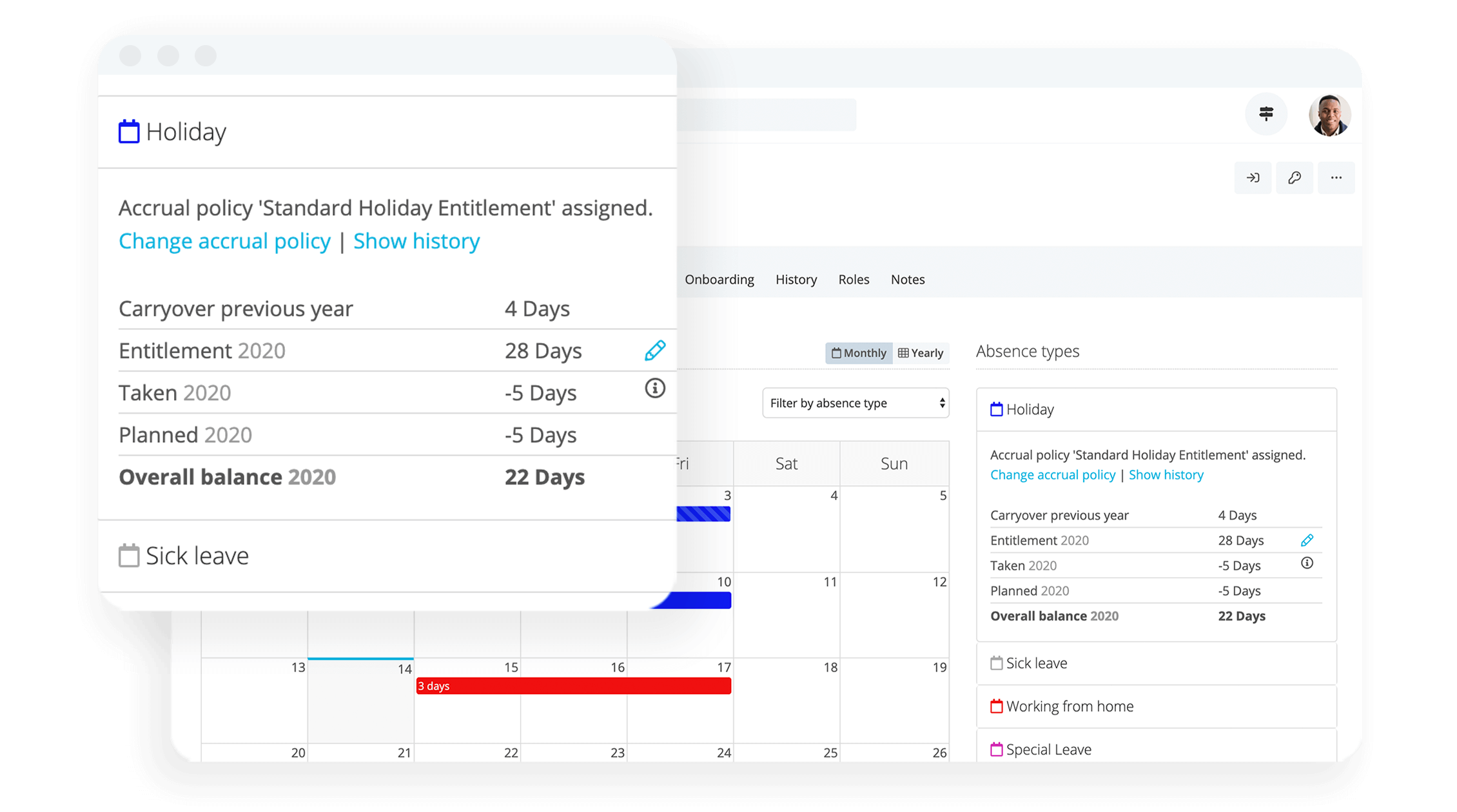What should you do with Bradford factor scores? Compile them in a list, make decisions based on them, or throw them all in the bin? There’s a lot of opinions out there and a lot to dive into. Today, we’ll get a handle on it.
Absences come in all shapes and sizes. Personio can help track them all.
Contents
What is the Bradford Factor?
How Do You Calculate Bradford Scores
What Is an Acceptable Bradford Score?
How Do You Evaluate Bradford Scores?
Is The Bradford Factor Fair?
Does The Bradford Factor Work?
Bradford Scores: Trust In More Holistic Absence Management Instead
What is the Bradford Factor?
The Bradford factor is an absence-oriented key performance indicator (KPI) designed to put a number behind the disruptive potential of ‘one-off’ absences when taken together. It is designed on the premise that short-term absences are more disruptive for an organization than long-term ones (like a planned vacation).
For many employers, absenteeism can be a crucial issue that affects both performance and company culture. That is why knowing more about it, and how to measure it, is top-of-mind for so many.
Essentially, having a compendium of Bradford scores is an easy way to get a handle on absenteeism and quantify it in a meaningful way for your organization.
How Do You Calculate Bradford Scores?
How do you calculate your Bradford score? The formula is as follows:
S2 × D = B
Let’s break down each of these variables:
- S stands for ‘spells,’ which are absences over a set period
- D is the total number of days of absence over the same period
- B is the resulting Bradford factor
In most cases, this set period is one year (52 weeks).
Bradford Score Example
Here is an example to help illustrate finding an employee’s Bradford score…
Let’s say we have two employees: Employee A and Employee B. Employee A recently came down with an illness and was sick for 10 days. Employee B was in relatively good health, but in that same period was sick on three separate occasions for a total of 10 days.
There Bradford scores would break down as follows:
- Employee A: 11 x 10 = 10
- Employee B: 33 x 10 = 90
In this case, Employee B’s multitude of absences, even though it amounted to the same number of days, would theoretically be more disruptive to business.
What Is an Acceptable Bradford Score?
A Bradford score in excess of 500 may warrant concern. That said, anywhere between the scores of 200 and 500 will begin to beg questions to get to the root of an employee’s absence. What follows are some Bradford score benchmarks to help us make sense of any scores you record…
| Score | What It Means |
|---|---|
| Under 50 | Typical score for an average employee |
| Over 50 | A threshold for concern or basic monitoringf |
| Over 100 | Potentially the start of a trend that requires keeping an eye on |
| Over 200 | Some kind of action may need to be required |
| Between 200-500 | A signal that something is going on that needs to be addressed |
| Over 500 | Potential grounds for dismissal or an in-depth meeting |
Keep in mind that this is far from set in stone. No two Bradford scores are the same, and they often require context to fully understand them. A Bradford score alone is not an indicator of how ‘good’ or ‘bad’ an employee is, it should be used more in context and as a signal that triggers actions that lead to decisions (and not to trigger any one decision).
How Do You Evaluate Bradford Scores?
Some companies may choose to identify trigger points with various Bradford scores, meaning that when an employee has reached a high enough number, something occurs. Here’s an example of what might happen:
| Score | Potential Action |
|---|---|
| 100 | Absence Review |
| 200 | Warning (Verbal/Written) |
| 400 | In-Depth Meeting |
| 700 | Potential Dismissal |
The issue is that these numbers are not set in stone, and the formula itself is relative to how a business or organization chooses to weigh it. While the scores typically climb with the severity of the action taken, this is only a rough example of how it might work.
Is The Bradford Factor Fair?
The problem with the Bradford factor is that it lacks nuance. The calculation itself is more of an indicator for a manager or HR team to ask questions, rather than make decisions. That is why you will almost always need ‘triggers’, based on Bradford scores, that result in certain measures in your organisation.
Mainly, it comes down to the fact that the Bradford factor cannot ‘weigh’ different kinds of absences, instead, it treats a day off work the same as it would a severe illness, a tragedy or disability. They all appear the same.
That has also made the Bradford factor when used alone, a topic of criticism and controversy. Therefore, it is best used as a measuring tool that informs a much larger discussion around absence and performance management.
It is a means to an end, but it is not the end-all and be-all.
Does The Bradford Factor Save Time?
The Bradford factor is a formula that can streamline the time of an HR department, but it still takes time to implement it. So, not only is the dataset less than reliable (or, at least, without context), it can take time from reliving the issues of absenteeism in the first place.
A More Streamlined Way To Manage Leave

Does The Bradford Factor Work?
Now that we understand the Bradford factor as one tool in a much larger discussion around performance management, let’s discuss what works about it.
The main thing is that it is easy. Bradford scores can offer a very quick, and very streamlined, way of calculating absences and having a very rough idea of what it means to the business.
Think of it as a signal. If an employee has an incredibly high Bradford score, it may not be enough evidence to warrant dismissal (or even a warning). It does, however, signal to HR that they may need more context and understanding of what is happening.
It can also reveal patterns within teams and departments of an organization, again serving as a signal that perhaps it is worth understanding why these things are happening. In and of itself, though, the Bradford factor is not definitive reasoning for punishment.
For instance, if HR noticed that certain months or time periods varied wildly in terms of absences, they could act more proactively in terms of offering flexible work, or developed initiatives to help with mental health in the workplace.
In its best light, then, the Bradford factor can be an empowering tool for HR to focus more on strategy rather than highlighting specific absences among employees.
Bradford Scores: Trust In More Holistic Absence Management Instead
As we discussed today, the Bradford Factor is merely one element of absence management. Therefore, it should be used in coordination with larger efforts and a more nuanced approach to tracking and evaluating when employees are away.
That said, building that system takes time. That’s why trusting an HR software that helps make absence management simpler can offer cleaner, more reliable, and ultimately, more actionable data for you and your organization.
Personio can help. Using our absence management tool, HR can have a quick glimpse at who is in the office, who is out, and what those trends mean over time. It means fewer calculations for your team, and cleaner data so you can focus on making changes and improvements.
This, in turn, helps with workforce planning and strategic HR initiatives. That’s because your team has the time, and the ability, to act on data that they would otherwise be calculating. Click on the banner below to learn more today.
See Our Absence
Tracking In Action





